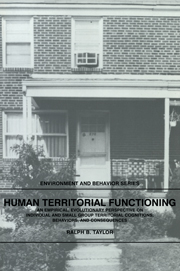 Human Territorial Functioning
Human Territorial Functioning Book contents
- Frontmatter
- Contents
- List of figures, tables, and boxes
- Series foreword
- Preface
- Acknowledgments
- 1 Introduction
- PART I ORIGINS OF HUMAN TERRITORIAL FUNCTIONING
- 2 Territorial functioning and related processes in different species
- 3 The origins of human territorial functioning
- 4 Theoretical perspectives on interpreting territorial functioning: exactly how did it evolve?
- PART II A CONCEPTUAL MODEL OF HUMAN TERRITORIAL FUNCTIONING
- PART III TERRITORIAL FUNCTIONING IN SETTINGS OF VARYING CENTRALITY
- PART IV APPLICATIONS TO SOCIAL PROBLEMS
- PART V REVIEW AND PROSPECTS
- Index
4 - Theoretical perspectives on interpreting territorial functioning: exactly how did it evolve?
Published online by Cambridge University Press: 05 February 2010
- Frontmatter
- Contents
- List of figures, tables, and boxes
- Series foreword
- Preface
- Acknowledgments
- 1 Introduction
- PART I ORIGINS OF HUMAN TERRITORIAL FUNCTIONING
- 2 Territorial functioning and related processes in different species
- 3 The origins of human territorial functioning
- 4 Theoretical perspectives on interpreting territorial functioning: exactly how did it evolve?
- PART II A CONCEPTUAL MODEL OF HUMAN TERRITORIAL FUNCTIONING
- PART III TERRITORIAL FUNCTIONING IN SETTINGS OF VARYING CENTRALITY
- PART IV APPLICATIONS TO SOCIAL PROBLEMS
- PART V REVIEW AND PROSPECTS
- Index
Summary
Social learning or cultural transmission can be modeled as a system of inheritance.
“Don't you understand? If they get in we're dead.”
– Dustin Hoffman, Straw DogsChapter 2 described territorial strategies in several different species. As the examples suggested, the specific forms of territorial functioning adopted were contingent upon resource distribution and social organization. Turning to primates, we saw that although some do engage in territorial functioning, other species, including some of our nearest phylogenetic neighbors, do not rely primarily on a territorial arrangement. Consequently, the question emerged In what ways might territorial functioning have enhanced the fitness of early hominids as they evolved from pongids? In Chapter 3 Lovejoy's male provisioning model provided the rationale for a home-based spatial organization, and considerations of diet, hunting, and defense from predation suggested that a small group, territorial-based system may have enhanced the inclusive fitness of protohominids and, later, early hominids.
Organization of the chapter
In this chapter we attempt to go further, more clearly specifying the exact forms of evolutionarily driven mechanisms responsible for the transmittal, development, and elaboration of territorial functioning. Within an evolutionary framework, there are three perspectives directly pertinent to territorial functioning. Very loosely, these are the instinct, group-based conservation, and sociobiology perspectives. The first, albeit dismissible, deserves mention given the popularity it has had. The second is noteworthy because it focuses attention on the relationship between the organisms in question, and their impacts on the ecology. The third perspective, sociobiology, is one on which we shall spend some time. Among sociobiologists, three “schools” can be distinguished those focusing on genetic transmission, those focusing on gene-culture interactions, and those focusing on cultural transmission.
- Type
- Chapter
- Information
- Human Territorial FunctioningAn Empirical, Evolutionary Perspective on Individual and Small Group Territorial Cognitions, Behaviors, and Consequences, pp. 43 - 76Publisher: Cambridge University PressPrint publication year: 1988
